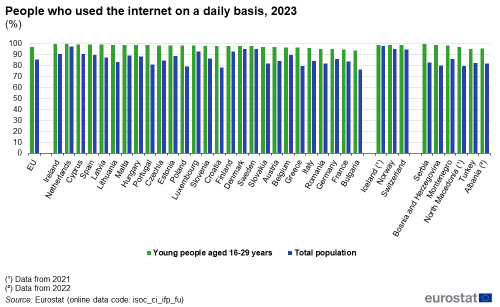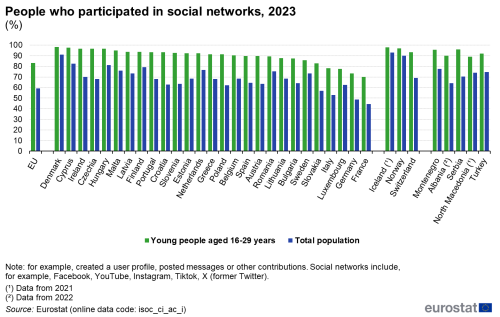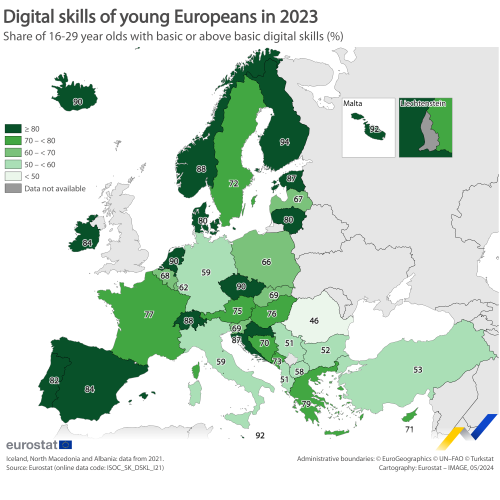A digital age gap
97 % of young people in the EU use the internet daily
In 2023, 97 % of young people aged 16-29 years in the EU reported using the internet every day compared to 86 % of the total population. In all EU countries, the share of the young people using the internet daily was between 94 % and 100 %.
While young people reported remarkably high shares of daily internet use in every country, Figure 1 shows that there is a much greater variation among the total population. On average, in the EU, the difference between the share of young people and that of the total population using the internet every day is 11 percentage points (pp). However, this gap is decreasing: in 2021, the difference was 15 pp, and in 2022, 12 pp. The digital age gap as reflected by daily use of internet was biggest in Croatia (20 pp), Poland (19 pp) and Portugal (18 pp). However, there is only a minor difference between the internet use of young people and the population as a whole in the Netherlands (2 pp difference), Sweden and Denmark (both 3 pp).
Most significant digital age gap seen in online social networking usage
Among the internet-based activities analysed, in 2023 participation in social networks was the most widespread among young people. Creating a user profile and posting messages or other activity was a widespread practice for at least 70 % of young people (in France), and up to 98 % (in Denmark and Cyprus) and averaging 83 % for the EU as a whole. Figure 2 gives more detailed information by EU Member State concerning the participation in online social networking in 2023. In 18 of the EU countries, at least 90 % of young people used social networking sites, while in a further 5 countries between 83% and 89 % of young people reported participating in these kind of networking activities. The participation of the total population ranged between 44 % (in France) to 91 % (in Denmark).
Across the EU, young people were much more likely to participate in social networking activities online than the total population. In fact, among the activities analysed in this article, the difference between the proportion of young people and that of the total population engaged in online activities was largest for participation in online social networks. This pattern was observed at EU level where the difference was 24 pp and in the EU countries, with the gap reaching 30 pp in Croatia and 29 pp in Slovenia, Poland and Czechia.
Youth online: a way of life
Discrepancies between EU countries regarding civic or political participation via the internet
In 2023, young people aged 16 to 29 years were, on average, more likely to express their opinion or take part in voting to define civic or political issues via the internet than the total population. When we look at participation in social networks young people have a 24-pp difference compared to the total population, in the case of civic or political participation the corresponding gap was 6 pp. The reason for the digital age gap being much smaller may also be partially linked to young people participating less in civic or political life in general.
In 2023, the civic or political participation online of young people was highest in Malta (43 % of 16 29-year-olds expressed an opinion or participated online in an activity linked to civic or political life), Estonia (39 %) and Hungary (36 %). By contrast, the lowest shares were observed in Cyprus (10 %), Belgium (14 %) and Czechia (15 %). In most EU countries, except Denmark and Austria, young people were more likely to use the internet for civic or political participation purposes than the total population. The largest differences were recorded in Croatia (15 pp), Slovenia (13 pp) and Greece (11 pp). In Denmark and Austria, the participation of the total population was slightly higher than that of the youth, namely with 2, respectively 1 pp.
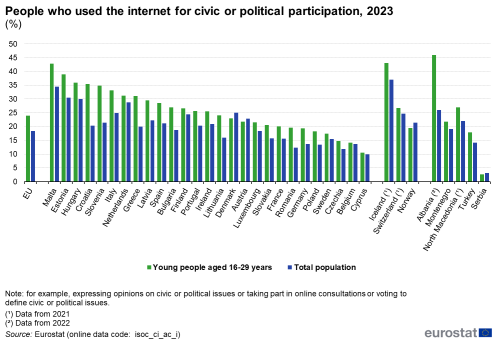
(%)
Source: Eurostat isoc_ci_ac_i
Online education declining from the 2021 peak
A clear example of how the internet and the related digital skills influence our lives is the surge in activities linked to education moving online, particularly in the context of the Covid19 pandemic.
However, this trend seems to be reversing. In 2021, 35 % of young people participated in an online course while in 2023 this share decreased to 23 %. Nevertheless, more than half (54 %) of young people aged 16-29 years in Finland made use of the internet for following an educational course, followed by 42 % in Malta and 38 % in Estonia. The lowest shares were 8 % in Romania and 10 % in Croatia. On average, in the EU 23 % of young people and 15 % of the total population used the internet for following an online course (see Figure 4).
In almost all EU countries, the young population was more likely to follow an online course than the rest of the population, the gaps being as large as 24 pp in Finland, 18 pp in Malta and 15 pp in France and Czechia. The one exception was Luxembourg, where the total population was 3 pp more likely to use the internet for doing an online course than the youth.
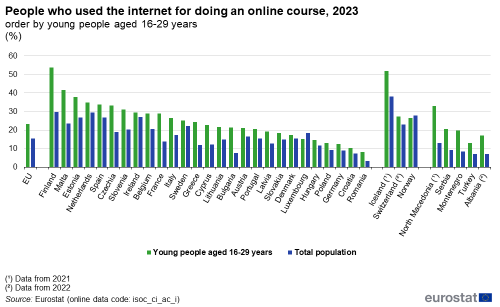
(%)
Source: Eurostat isoc_ci_ac_i
Verifying sources
Although the internet can provide a place for people to share their experiences and to exchange their views, there are also risks. It is equally important to address safety concerns and to enable young people to analyse, compare and critically evaluate the credibility and reliability of sources of data, information and digital content.
At EU level, 36 % of the high number of young people using the internet engaged in activities related to fact-checking online information and its sources. Only in four countries, was the share of young internet users who assess the truthfulness of the internet content above 50 %, the highest being in Finland (61 %) and the Netherlands (60 %). The lowest shares were recorded in Cyprus (11 %), Bulgaria (14 %) and Romania (15 %). Regarding the lowest rates of verifying sources there has been a decrease since last year when the lowest recorded share was 18 % (in Cyprus). In 2023, the share of young internet users verifying sources declined in 14 countries compared to the previous year.
Young internet users are more inclined to fact-check online information than the population as a whole. In 2023 the difference was 9 pp more for young people than the EU level. The gap reached 21 pp in Finland and 20 pp in Croatia. Ireland was the only country for which this pattern was reversed; 6 pp more of the total population of internet users checked the information compared to young internet users (see Figure 5).
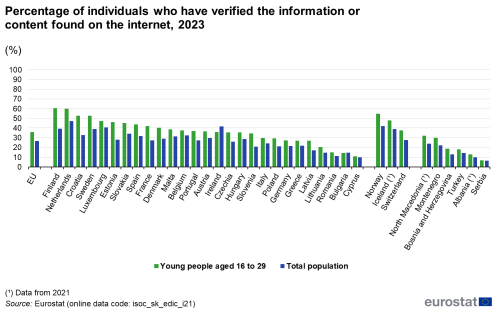
(%)
Source: Eurostat isoc_sk_edic_i21
Internet use dynamics over time
How has the use of internet for everyday activities changed over time?
In 2023, 83 % of young people aged 16-29 used the internet to participate in social media networks in the EU. However, this is not much higher than the 81 % measured in 2014, nor much lower than the 85 % peak measured in 2018 and 2020. Other uses show a greater variation.
During the COVID-19 pandemic, most activities saw an increase, most notably when it came to using the internet for online courses, which jumped from 13 % in 2019 to 35 % in 2021. However, in 2022, that percentage decreased to 28 % (-7 pp), and then further to 23 % in 2023.
The use of internet for banking has been consistently increasing since 2014 (when it stood at 45 % of young people) reaching 67 % in 2023. Reading news online peaked in 2020 (73 %) and has since lost momentum as the percentage of young people reading online decreased by 7 pp in 2023 compared to that peak.
In 2023, only 24 % of young people used the internet for civic or political participation, an activity that has registered a 5 pp increase since 2015.
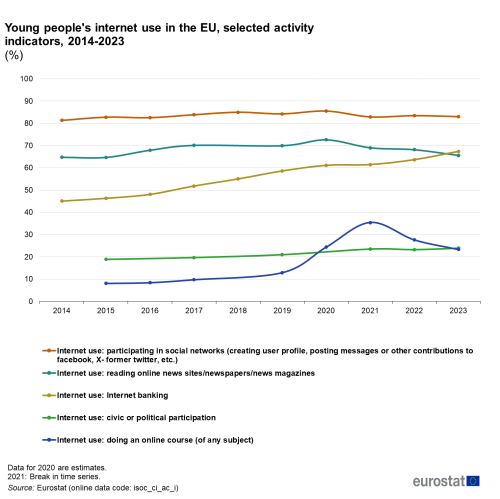
(%)
Source: Eurostat isoc_ci_ac_i
Digital skills
ICT skills are regarded as being essential to benefit from and contribute to a knowledge-based economy and society. By the time young people in the EU leave compulsory education, most of them have regularly made use of computers and the internet for a variety of activities. In this context, it is important that young people become empowered and responsible digital users, equipped with appropriate digital skills.
Map 1 highlights the share of young people between the age of 16 and 29 reporting basic or above basic overall digital skills in 2023. Country shares range from 94 % in Finland, 92 % in Malta, 90 % in Czechia and the Netherlands, to 46 % in Romania and 52 % in Bulgaria. The EU average stands at 71 %.
In 2023, at EU level there were more young females (73%) who reported having basic digital skills compared to young males (69%). This trend can also be seen in most countries. The largest gap in favour of young females was registered in Croatia where 94 % of young females compared with only 80 % of young males have at least basic digital skills. The opposite can be seen in five other EU countries where the share of young males with at least basic digital skills is slightly higher than young females (Germany, Malta, Romania, Estonia and Slovakia).
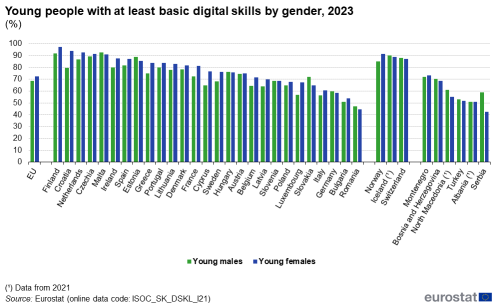
(%)
Source: Eurostat isoc_sk_dskl_i21
Digital skills refer to five areas: information and data literacy skills, communication and collaboration skills, digital content creation skills, safety skills and problem-solving skills. To have basic overall digital skills, people must have declared performing at least one activity related to each area in the 3 months preceding the survey.
Taking examples from these domains, some of the activities used to measure digital skills are analysed in more detail below (further information on the types of activities related to each skill is available in the metadata file). Notably:
- Participating in social networks (communication and collaboration);
- Writing code in a programming language (digital content creation);
- Using the internet for civic or political participation (communication and collaboration);
- Using the internet for doing an online course (problem solving).
The share of young people who had written computer-programming code was twice as high as the share for the total population
In 2023, almost four fifths (77 %) of all young people aged 16-29 years in the EU reported that they had (at any time in the past) performed basic computer tasks such as copying or moving a file or a folder, while slightly lower shares had downloaded or installed software or applications (72 %).
More technical competences, such as writing code in a programming language, were much less widespread. Just 13 % of young people in the EU reported writing code in the 3 months preceding the survey, although this was almost double the 7 % share that was recorded for the total population.
Figure 8 shows the differences between males and females. At EU level, 18 % of males and 8 % of females have written code in a programming language. When it comes to females Malta takes the lead with 20 % of young women having done some coding, followed by Portugal (17 %) and Spain (16 %). The lowest share of female code writers was recorded in Bulgaria and Romania (both 2 %). The highest share of males writing code in a programming language was observed in the Netherlands at 31 %, followed by Estonia (30 %), Portugal and Finland (both at 29 %). In contrast, four countries recorded less than 10 % of males in that category, namely Bulgaria (4 %), Romania (5 %), Cyprus and Greece (both at 7 %).

(%)
Source: Eurostat isoc_sk_cskl_i21
Conclusions: what future for young people in the digital world?
This article has shown that the use of ICT is widespread among young people and is, in some instances, reaching saturation. Young people make use of the internet more commonly than the total population as a whole and it seems likely that this pattern will continue.
The challenge for policymakers within this domain will be to ensure that the social and economic benefits from exploiting ICT is delivered in unison with the safe use of digital media, in particular for more vulnerable sections of society.
Source data for tables and graphs
![]() Being young in Europe today – digital world: tables and figures
Being young in Europe today – digital world: tables and figures
Data sources
The data presented in this article come from Eurostat’s survey on ICT usage in households and by individuals, which is updated on an annual basis to ensure that the data collected remain relevant. While the questions and areas of interest for the surveys change each year to reflect modern ICT use, there is a core section of the survey which aims to provide stable and continued data collection for several key indicators thereby making analyses over time possible. ICT surveys initially concentrated on access and internet connectivity issues, but their scope has subsequently been extended to cover a variety of subjects, including for example internet security or the use of social media and cloud services. The results of the survey can be studied according to a range of socioeconomic categories, including sex, age, educational differences or whether there are children or not in a household. In most EU countries, the surveys are carried out in the second quarter of each year asking about activities in the first quarter of the same year; sometimes questions (for example, on e-commerce or e-government) are asked about activities during the previous 12 months.
ICT surveys cover households having at least one member in the age group 16-74 years. Households with children are those with at least one member aged less than 16 years. Within this article statistics that refer to the total population cover those aged 16-74 years while young people is a collective term used to describe the subpopulation of people aged 16-29 years.
Context
A EUROPE FIT FOR THE DIGITAL AGE
In her agenda for Europe, the President of the European Commission, Ursula von der Leyen, outlined a set of priorities for the period 2019-2024. In February 2020, the European Commission adopted a Communication on Shaping Europe’s digital future, which highlights the opportunities that exist around developing new technologies such as artificial intelligence and 5G networks, or exploiting a wealth of potential information from big data. Alongside encouraging businesses to develop these new technologies, the strategy also ensures that any new developments are made while ensuring the trust of European citizens (trustworthy technologies, fostering an open and democratic society, enabling a vibrant and sustainable economy, helping to combat climate change and promote a green transition).
Digital skills indicators are some of the key performance indicators in the context of the Digital Decade, which sets out the EU’s vision for digital transformation. The Digital Compass sets out an aim for 80% of EU citizens aged 16-74 years old to have basic digital skills by 2030.
BETTER INTERNET FOR OUR CHILDREN
As well as providing opportunities for work, study, leisure activities and social interaction, the internet contains hazards for all users. The basis of the European Commission’s Digital Decade Better Internet for kids strategy is to protect children and to make children and young people more aware of the risks involved with using the internet, while teaching digital literacy so that children may benefit fully and safely from being online. The strategy, which was adopted in May 2012, was based around four pillars: stimulate quality content online for young people; step up awareness and empowerment; create a safe environment for children online and fight against child sexual abuse and child sexual exploitation.
INSAFE, INHOPE AND SAFER INTERNET
Insafe and Inhope are European networks, co-funded by the EU, made up of national Safer internet centres. The national centres implement awareness and educational campaigns, run helplines and work closely with young people to ensure an evidence-based, multi-stakeholder approach to creating a better internet.
On 6 February 2018, the EU launched a range of new initiatives under the heading of Safer internet day. They were designed to ensure that children, young people, parents, teachers and other EU citizens become empowered and responsible digital users. The web portal for this initiative Better internet for kids provides access to a wealth of information including an online course on child safety with teaching resources for topics such as fake news, cyberbullying and radicalisation.

